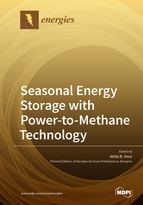Seasonal Energy Storage with Power-to-Methane Technology
A special issue of Energies (ISSN 1996-1073). This special issue belongs to the section "D: Energy Storage and Application".
Deadline for manuscript submissions: closed (10 August 2021) | Viewed by 24683
Special Issue Editor
Interests: thermodynamics; energy engineering; supercritical and metastable states; energy storage and conversion; geothermal and waste heat utilization; phase equilibria
Special Issues, Collections and Topics in MDPI journals
Special Issue Information
Dear Colleagues,
To have a sustainable society, the need to use renewable sources to produce electricity is inevitable. Due to the fluctuation of some of these sources (wind, solar), utility-scale energy storage has to be used. These fluctuations are wide-ranging, from minutes (passing cloud) to whole seasons (winter/summer solar availability). Short-time storage can be solved (at least theoretically) with batteries, but seasonal storage—due to the amount of storable energy and the self-discharging of some storage methods—is a challenge.
Recently, among the classical long-term storage technologies (such as pumped hydro-storage), novel methods are available. Batteries are better and better with less self-discharge and bigger energy density; therefore, they can be used for seasonal storage, although they cannot cover the total need. Therefore, Power-to-Gas methods (mainly Power-to-Hydrogen, P2H, and Power-to-Methane, P2M) play a bigger and bigger role in the storage mix. In these methods, surplus electricity is used to electrolyze water and produce hydrogen; this hydrogen can be stored and used later to recover electricity. Alternatively, with added carbon-dioxide, it can be turned to methane through chemical or biochemical methods, and subsequently, the methane can be stored and used later to recover electricity. Comparing the two methods, the recovery ratio is better for P2H; nonetheless, loss-free storage and recovery needs special equipment. By contrast, for P2M—being the produced methane in SNG, i.e., synthetic natural gas—existing gas-storage facilities can be used for storage and recovery can be achieved through the existing mature methods (like gas engines). Although the step for electricity recovery is associated with carbon-dioxide emission, the amount of emitted CO2 is equal to the one used for the synthesis; therefore, this technology can also be considered carbon-free.
This Special Issue is dedicated to Power-to-Methane technology. It can be used not only to help seasonal energy storage but also to enrich low-quality biogases and natural gases by turning their CO2 content to methane. P2M technology is now on the verge of full-scale industrial use; therefore, a Special Issue dedicated to this method would be very timely.
Prof. Dr. Attila R. Imre
Guest Editor
Manuscript Submission Information
Manuscripts should be submitted online at www.mdpi.com by registering and logging in to this website. Once you are registered, click here to go to the submission form. Manuscripts can be submitted until the deadline. All submissions that pass pre-check are peer-reviewed. Accepted papers will be published continuously in the journal (as soon as accepted) and will be listed together on the special issue website. Research articles, review articles as well as short communications are invited. For planned papers, a title and short abstract (about 100 words) can be sent to the Editorial Office for announcement on this website.
Submitted manuscripts should not have been published previously, nor be under consideration for publication elsewhere (except conference proceedings papers). All manuscripts are thoroughly refereed through a single-blind peer-review process. A guide for authors and other relevant information for submission of manuscripts is available on the Instructions for Authors page. Energies is an international peer-reviewed open access semimonthly journal published by MDPI.
Please visit the Instructions for Authors page before submitting a manuscript. The Article Processing Charge (APC) for publication in this open access journal is 2600 CHF (Swiss Francs). Submitted papers should be well formatted and use good English. Authors may use MDPI's English editing service prior to publication or during author revisions.
Keywords
- Power-to-Fuel technologies
- Seasonal energy storage
- Grid-stability
- SNG, SynGas
- Biomethane






